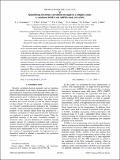Files in this item
Quantifying electronic correlation strength in a complex oxide: a combined DMFT and ARPES study of LaNiO3
Item metadata
| dc.contributor.author | Nowadnick, E. A. | |
| dc.contributor.author | Ruf, J. P. | |
| dc.contributor.author | Park, H. | |
| dc.contributor.author | King, Phil | |
| dc.contributor.author | Schlom, D. G. | |
| dc.contributor.author | Shen, K. M. | |
| dc.contributor.author | Millis, A. J. | |
| dc.date.accessioned | 2016-01-20T17:10:06Z | |
| dc.date.available | 2016-01-20T17:10:06Z | |
| dc.date.issued | 2015-12-15 | |
| dc.identifier.citation | Nowadnick , E A , Ruf , J P , Park , H , King , P , Schlom , D G , Shen , K M & Millis , A J 2015 , ' Quantifying electronic correlation strength in a complex oxide: a combined DMFT and ARPES study of LaNiO 3 ' , Physical Review. B, Condensed matter and materials physics , vol. 92 , no. 24 , 245109 , pp. 1-9 . https://doi.org/10.1103/PhysRevB.92.245109 | en |
| dc.identifier.issn | 1098-0121 | |
| dc.identifier.other | PURE: 232972918 | |
| dc.identifier.other | PURE UUID: 38730c47-80a1-4296-a320-1831df73c8cc | |
| dc.identifier.other | Scopus: 84952332394 | |
| dc.identifier.uri | https://hdl.handle.net/10023/8046 | |
| dc.description.abstract | The electronic correlation strength is a basic quantity that characterizes the physical properties of materials such as transition metal oxides. Determining correlation strengths requires both precise definitions and a careful comparison between experiment and theory. In this paper, we define the correlation strength via the magnitude of the electron self-energy near the Fermi level. For the case of LaNiO3, we obtain both the experimental and theoretical mass enhancements m☆/m by considering high resolution angle-resolved photoemission spectroscopy (ARPES) measurements and density functional + dynamical mean field theory (DFT + DMFT) calculations. We use valence-band photoemission data to constrain the free parameters in the theory and demonstrate a quantitative agreement between the experiment and theory when both the realistic crystal structure and strong electronic correlations are taken into account. In addition, by considering DFT + DMFT calculations on epitaxially strained LaNiO3, we find a strain-induced evolution of m☆/m in qualitative agreement with trends derived from optics experiments. These results provide a benchmark for the accuracy of the DFT + DMFT theoretical approach, and can serve as a test case when considering other complex materials. By establishing the level of accuracy of the theory, this work also will enable better quantitative predictions when engineering new emergent properties in nickelate heterostructures. | |
| dc.format.extent | 9 | |
| dc.language.iso | eng | |
| dc.relation.ispartof | Physical Review. B, Condensed matter and materials physics | en |
| dc.rights | © 2015 American Physical Society. This work is made available online in accordance with the publisher’s policies. This is the final published version of the work, which was originally published at http://dx.doi.org/10.1103/PhysRevB.92.245109. | en |
| dc.subject | QC Physics | en |
| dc.subject | NDAS | en |
| dc.subject.lcc | QC | en |
| dc.title | Quantifying electronic correlation strength in a complex oxide: a combined DMFT and ARPES study of LaNiO3 | en |
| dc.type | Journal article | en |
| dc.description.version | Publisher PDF | en |
| dc.contributor.institution | University of St Andrews. School of Physics and Astronomy | en |
| dc.contributor.institution | University of St Andrews. Condensed Matter Physics | en |
| dc.identifier.doi | https://doi.org/10.1103/PhysRevB.92.245109 | |
| dc.description.status | Peer reviewed | en |
This item appears in the following Collection(s)
Items in the St Andrews Research Repository are protected by copyright, with all rights reserved, unless otherwise indicated.

